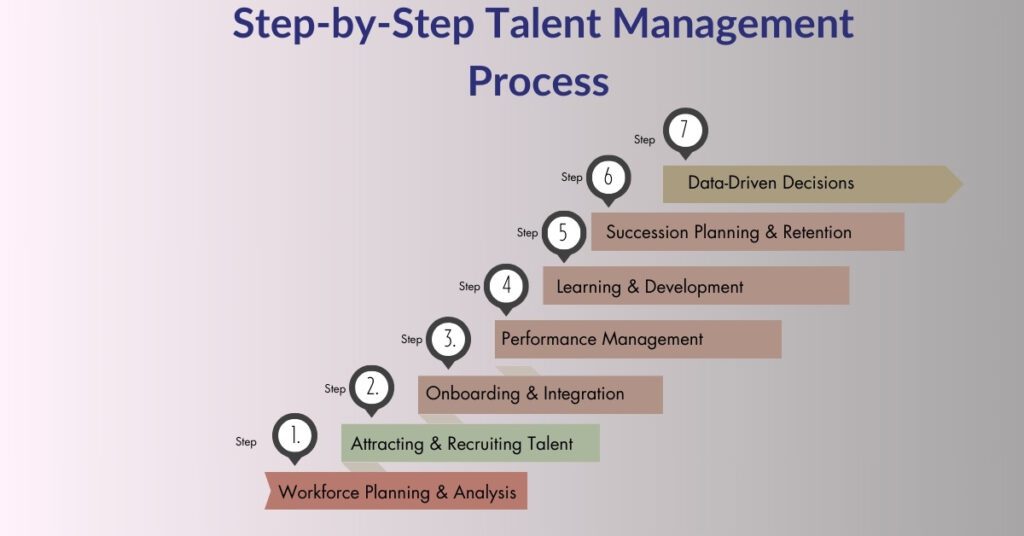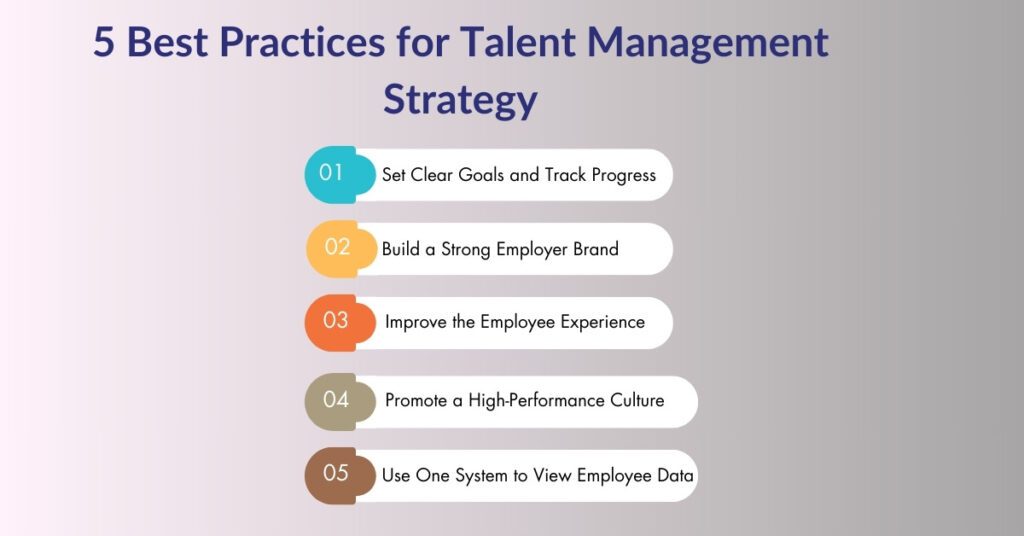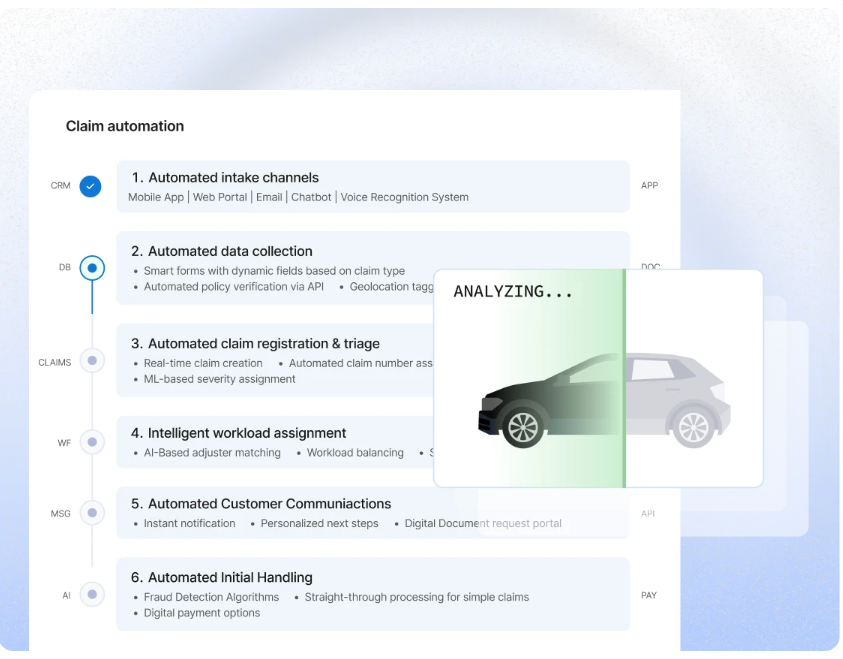Human resources has many responsibilities in a company. The department handles employee relations, hiring, payroll, onboarding, and more. Another important task of HR is talent management
HR personnel play a crucial role in supporting businesses as well as nurturing employee talent development programs.
Companies need more than hiring smart people if they hope to remain competitive; Talent Management provides this essential service.
No matter if you are an HR pro, business owner, or simply curious to learn how companies retain top talent, here is something that may interest you.
Talent management involves recruiting, training, and retaining the best people so your business thrives.
Let’s break down talent management strategies and best practices step-by-step:
Table of contents

What is Talent Management?
Talent management is the strategic process of hiring, motivating, and helping professionals grow so they can contribute the most to your organization.
Talent management covers everything from hiring and onboarding new employees while training and managing performance to keeping existing staff satisfied and engaged.
Talent management is an important component of human capital management (HCM).
It helps to plan and improve how the company supports its employees, with specific tasks designed to assist and contribute to their wellbeing and the company’s success.
Talent Management Strategies
Talent management strategies help companies identify, recruit and retain top employees.
A talent management plan must align with the company’s goals and outline which employees are needed for its success.
Based on this plan, talent should be managed by your company effectively.
Here are three main strategies you can use for managing talent:
Strategy #1: Hire Only Top Employees
This strategy means hiring the best and most skilled employees from the start.
The goal is to bring in high performers who can contribute immediately to the company’s growth.
Advantages:
- Immediate Access to Top Talent: You get the best workers who are ready to perform well from day one.
- Quick Results: These employees usually perform at a high level and help the company grow faster.
- Faster Company Growth: High performers can push the company to reach its goals quickly.
- Prepared for Challenges: Top talent is often good at solving problems and handling risks, so the company is better prepared for challenges.
Disadvantages:
- Expensive Hiring: Hiring top employees costs more in salary and recruiting. If they leave or don’t work out, it can be even more expensive to replace them.
- Difficult to Keep Top Talent: Top employees are highly sought after by other companies, so it can be hard to keep them around.
- Longer Hiring Process: It may take more time to find the right top employees because you have to choose from a large group of candidates.
- Managing a Team of High Performers: Too many top performers in one team can cause competition and friction, which may reduce performance.
Strategy #2: Hire Promising Specialists and Develop Them
This strategy focuses on hiring people who may not be top performers yet but have potential. The company then helps them grow and improve their skills.
Advantages:
- Faster Hiring: You can find promising employees more quickly, which is helpful if you need workers right away.
- Lower Hiring Costs: These employees typically cost less than top talent, so you can save money.
- Growth Potential: With the right training, these employees can become valuable and loyal workers over time.
- More Hires for the Same Cost: For the same budget, you can hire more promising employees, which can increase your talent pool.
Disadvantages:
- Slower Company Growth: It may take longer for these employees to reach their full potential, which can slow down the company’s progress.
- Lower Performance at First: These hires may not perform as well as top talent initially, so the company may not see high results right away.
- Need for More Hiring: If a promising specialist can’t handle the job, you may need to hire someone else, which can increase costs.
- More Investment in Training: You’ll need to spend time and money helping these employees grow, which can be a bigger investment.
- Risk of Failure: There’s a chance that the strategy might not work, and you’ll have to switch back to hiring top employees.
Strategy #3: Combine Strategies 1 and 2
This strategy combines the best of both previous strategies. It involves hiring a mix of top talent and promising specialists to benefit from both immediate high performance and long-term growth.
Advantages:
- Best of Both Worlds: You get both experienced employees who can perform well right away, and new talent who can grow with the company.
- Faster Growth for Specialists: Top employees can help train and motivate the specialists, making them improve faster.
- Knowledge Sharing: The experienced employees can teach the specialists, which helps everyone in the company grow.
- Better Team Dynamics: A combination of top talent and new specialists makes the team more balanced and dynamic, as they bring different skills to the table.
Disadvantage:
- Conflicting Needs: If your company needs quick results or has a tight budget, it might be better to focus on just one strategy instead of combining both.
Step-by-Step Talent Management Process

Managing talent is more than just hiring people. It’s about helping them grow, succeed, and stay with your company for the long term.
Below is a step-by-step breakdown of the Talent Management Process explained in simple, clear language.
Step 1. Workforce Planning & Analysis
Before you start hiring, take a good look at your current team.
Ask yourself:
- What skills do our employees already have?
- What important skills are missing?
- Are we ready for the changes coming in our industry?
Workforce planning helps you understand your strengths and weaknesses.
You can use data and reports to see where the gaps are and how to fill them.
Maybe you need to train your current team or bring in new people. This plan is your roadmap.
Tip: Align your workforce plan with your future business goals.
Step 2. Attracting & Recruiting Talent
Once you know what you need, it’s time to find the right people.
To attract talent, you need to build a strong employer brand. This means showing potential hires that your company is a great place to work.
Use your website, social media, and employee stories to showcase your values and work culture.
Then, recruit in different ways use job boards, social media, referrals, recruitment agencies, and even campus hiring.
The more diverse your approach, the better your chances of finding great talent.
Also, make sure your hiring process is inclusive and fair. Everyone should have an equal chance.
Tip: Don’t just look for experience, look for passion and potential too.
Step 3. Onboarding & Integration
Hiring someone is only the beginning. The next step is onboarding, and it matters a lot.
Onboarding means helping your new hire feel welcome and comfortable from day one.
Introduce them to the company, show them around, and help them meet the team. Give them a clear idea of their role, responsibilities, and what success looks like.
Assigning a mentor or buddy can really help, especially in the first few weeks. Also, provide proper training so they don’t feel lost or overwhelmed.
Tip: A great onboarding experience increases employee retention and satisfaction.
Step 4. Performance Management
After a smooth start, you need to keep track of how employees are doing.
Set clear goals for each person and make sure they understand what’s expected. Don’t wait for the yearly review, give regular feedback.
Tell them what they’re doing well and where they can improve.
Use fair, transparent systems to measure performance.
Recognize and reward good work. Employees stay motivated when they know their efforts matter.
Tip: People perform better when they get feedback often, not just once a year.
Step 5. Learning & Development
No matter how experienced someone is, there’s always room to grow.
Offer training programs, workshops, and online courses to help employees learn new skills. Help them grow professionally and personally.
Build career paths so they know what steps to take for promotion or new roles.
Also, encourage continuous learning in a culture where people want to keep improving and trying new things.
Tip: When employees learn and grow, they stay longer and do better work.
Step 6. Succession Planning & Retention
What happens when a manager leaves suddenly?
Succession planning means identifying team members who have the potential to take on bigger roles in the future.
Start training and preparing for them early. This way, there’s always someone ready to step up.
At the same time, focus on retention and keeping your best people happy and loyal.
Offer good pay, benefits, and flexible work options like remote or hybrid schedules.
Give them meaningful work and growth opportunities, and make sure they feel appreciated.
Tip: It’s much cheaper and better to keep great employees than to hire new ones all the time.
Step 7. Data-Driven Decisions
Lastly, use data and analytics to guide your talent strategy.
Track things like:
- How long does it take to hire someone?
- Why are people leaving?
- Who is performing well?
This information will help you improve your processes.
For example, if many employees leave in the first 6 months, your onboarding might need fixing.
If hiring takes too long, your recruitment process might need speeding up.
Tip: Let the numbers speak, don’t rely only on guesswork.
5 Best Practices for an Effective Talent Management Strategy

Even with good planning, many companies struggle with talent management because of problems like bad data, too much manual work, lack of support from top leaders, and hidden bias in decisions.
To overcome these issues, here are five key practices that can help improve your talent management strategy:
1. Set Clear Goals and Track Progress
People are the heart of a business, so HR should work closely with company leaders to set clear goals.
When everyone from top to bottom knows what the business is trying to achieve, employees understand their roles better and perform more confidently.
2. Build a Strong Employer Brand
Job seekers today want more than just a good salary.
They ask: “Does this company share my values?
Will I feel proud working here?”
That’s why businesses need a strong brand that reflects things like diversity, sustainability, and employee well-being.
If people feel proud of the company they work for, they’re more likely to stay and perform well.
3. Improve the Employee Experience
Employees expect the same smooth experience at work as they get when shopping online.
With modern HR software (like HCM tools), employees can easily access information and services, even from their phones.
Take Watco Companies as an example. When they grew quickly, paperwork became a problem.
They switched to a digital HR system that gave employees quick access to personal info and services.
This made work easier and more enjoyable for everyone, happier employees mean happier customers.
4. Promote a High-Performance Culture
A strong talent strategy helps people do their best by offering the right training, rewards, and promotion opportunities.
Regular feedback not just once a year helps employees grow and feel motivated.
Instead of waiting for yearly reviews, frequent feedback helps employees improve and feel valued, which boosts productivity and supports business success.
5. Use One System to View Employee Data
It’s important to have a clear, full view of each employee.
A flexible system that stores everything in one place helps leaders spot skill gaps, track progress, and guide careers more easily.
Having one data source makes it easier for HR and managers to make smart, timely decisions that support employees and business goals.

Conclusion
Talent management is all about finding the right people, helping them grow, and keeping them happy in your company.
Planning is more than hiring; it’s about building a strong team for the future.
By following simple steps like planning, hiring, onboarding, training, and providing regular feedback to employees on performance improvements in order to accelerate company growth and performance improvement.
Good talent management ensures employees feel valued, work harder, stay longer with you – it’s the keystone of business success!
If you want your business to thrive and expand then taking good care of its people should be the starting point.
FAQs
To attract, develop, and retain high-performing employees who align with business objectives.
HR covers broader responsibilities (like payroll and compliance), while talent management focuses on employee growth and retention.
Start small: clarify roles, onboard well, give feedback, and provide training. Use cost-effective tools or platforms.
HCM software, performance tracking apps, LMS (Learning Management Systems), and analytics dashboards.
Higher turnover, lower productivity, poor employee morale, and a weaker employer brand.








